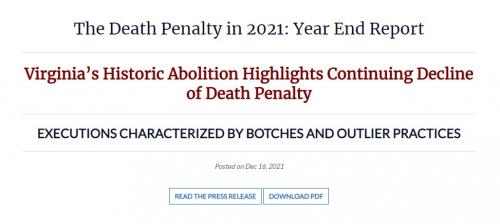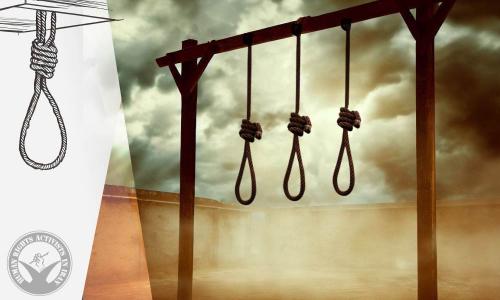12 January 2022 :
Death Penalty Information Center: Year End Report 2021. Virginia abolishes, 11 executions, 19 new death sentences. Executions and Death Sentences Near Record Lows in 2021, as Virginia Becomes First Southern State to Abolish the Death Penalty
Virginia’s historic abolition of the death penalty highlighted a year in which public opinion polls, executions, and new death sentences all signaled continued erosion of support for capital punishment across the United States.
As of the en of December, 19 people had been sentenced to death in 2021, almost matching the record low since the beginning of the modern era of the death penalty in 1972 set in 2020. Five states and the federal government carried out 11 executions in 2021, down from 17 executions in 2020. The 11 executions conducted this year were the fewest since 1988. The pandemic contributed to these historically low numbers, but the trend is clear: 2021 marked the seventh consecutive year where there were fewer than 50 death sentences and 30 executions, according to a report released today by the Death Penalty Information Center (DPIC).
“The death penalty grew increasingly geographically isolated in 2021 and public support dropped to its lowest levels in a half-century,” said Robert Dunham, DPIC’s Executive Director. “Virginia’s repeal created a death-penalty-free zone along the U.S. Atlantic coast that now runs from the Canadian border of Maine to the northern border of the Carolinas. In the west, an execution-free zone spans the Pacific coast from Alaska to Mexico. The handful of states that continue to push for capital punishment are outliers that often disregard due process, botch executions, and dwell in the shadows of long histories of racism and a biased criminal legal system.” DPIC takes no position on the death penalty, but has been critical of how it is administered. “We are seeing fewer and fewer executions, but those that do occur demonstrate that the death penalty is not reserved for the worst of the worst, but the most vulnerable of the vulnerable,” said Ngozi Ndulue, DPIC’s Deputy Director. “The federal government began 2021 with the last three executions of the historically aberrant federal execution spree, executing people with severe mental illness, intellectual disability, and unexamined evidence of innocence. The state executions since then followed the same pattern. All but one prisoner executed this year had significant impairments such as serious mental illness; brain injury or damage; an IQ in the intellectually disabled range; or chronic serious childhood trauma, neglect and abuse.”
With Virginia’s abolition in March, a majority of states have now abolished the death penalty (23) or have a formal moratorium on its use (3). An additional ten states have not carried out an execution in at least ten years. Bipartisan legislation to repeal the death penalty is moving through the Ohio and Utah legislatures. Only five states and the federal government carried out executions in 2021. Texas and the federal government each executed three people. Oklahoma executed two. Three states – Alabama, Mississippi, and Missouri – each executed one person. The change in presidential administrations ended the federal government’s aberrant execution spree and put federal executions on pause. However, the Biden administration has sent mixed messages on its death penalty policy and has taken no steps in response to calls to end all federal death penalty prosecutions and commute the sentences of the prisoners on federal death row. Seven states imposed new death sentences this year.
Oklahoma and Alabama each imposed four new death sentences. California and Texas handed down three. Florida imposed two new death sentences, while Nebraska and Tennessee each imposed one. Only two counties — Los Angeles County, California and Oklahoma County, Oklahoma — imposed more than one death sentence, with each imposing two. Racism continued to infect the use of the death penalty in 2021, as it has since the nation’s beginnings. The majority of those sentenced to death in 2021 (11 of 19, 57.89%) were Black or Latinx; 56% of those executed (6 of 11) were Black. 83.3% of the death sentences and half of the executions involving Black men were for interracial offenses, as were three of the four new death sentences imposed on Latino defendants. More than ¾ of new death sentences (14 of 19) involved a white victim and no white person was condemned or executed in a case that didn’t involve a white victim. Other key findings in “The Death Penalty in 2021: Year End Report” include:
Two more innocent death-row prisoners were exonerated in 2021, bringing the number of wrongfully-convicted people exonerated from death row since 1972 to 186. That amounts to one exoneration for every 8.3 executions in the modern era.
An analysis of 600 death penalty public opinion surveys conducted over the course of 75 years indicated that public support for capital punishment has steadily declined since the 1990s and was lower in 2021 than at any other time since 1966. Three states — Alabama, Oklahoma, and Texas — accounted for a half of all death sentences and a majority of executions. For a seventh straight year, there were no executions west of Texas.
The continuing geographic isolation and arbitrariness of the death penalty was reflected in the fact that just five counties — Harris, Dallas, Tarrant, and Bexar in Texas and Oklahoma County in Oklahoma — now account for more than 20% of all executions in the United States since the 1970s.
Notably, there were no death sentences in many formerly high-use death penalty counties, including Harris County, Texas; Philadelphia County, Pennsylvania; and Duval County, Florida. The election of reform prosecutors in those and many other counties has played a significant role in the declining number of new death sentences.
The Death Penalty in 2021: Year End Report | Death Penalty Information Center











